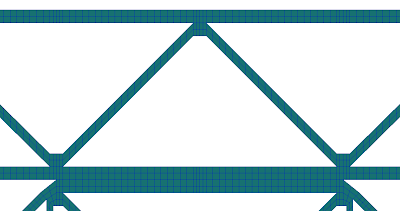Customer Spotlight: Midlands Simulation Group
Hierarchical Structure Analysis
Comparing an I-beam or box section girder with a solid beam of same dimension shows that the girder is much lighter - but just as stiff. Similarly, a sandwich panel of differing core thickness, but identical skin provides equally light – but ~40 times more stiff.It turns out that making an I-Beam girder out of lots of little girders improves the efficiency further - and most likely better able to withstand impact. This is a "hierarchical" or cellular structure.
The Eiffel Tower is a classic example of a 3rd degree hierarchical structure. Even with its relatively poor quality iron, it is more resource efficient than many a modern skyscraper.
An attractive manufacturing route is that of bonding of layers (laminating), forming to shape and then inflating to stiffness. The layers are not bonded everywhere: on inflation, the un-joined regions separate and form internal struts or membranes (miniature honeycomb or I-beams) where the outer layers are much thinner than the inner ones (initially). The latter are stretched much more to form webs or supporting walls.
The structures are hollow and inflated from low density structured or cellular materials - for either metallic or polymer applications.
Such structures can provide greater than 80% weight reduction.
Julian Spence from the Midlands Simulation Group, which is part of the University of Wolverhampton is investigating the impact absorption properties of a novel cellular material they are looking to develop. Therefore it is of high importance to attain the possible properties of the 3D material prior to manufacture.
To start the study a 2D model was created and analysed in Dytran. For the material itself, a Johnson-Cook material model for an aluminium alloy was used. The results showed how there are more modes of deformation available in a cellular structure which are able to absorb and dissipate the impact energy with greater material efficiency.
A repeating section of the model that was analysed is shown below. The overall height of the structure is 22mm to give a sense of scale with the impactor travelling at 100m/s.
A further zoomed in view for the comparative mesh size (central small triangle shown):
The elastic, plastic and kinetic energy behavioural properties of the bodies, as well as the body forces could help inform the design of armour or impact absorbing structures, such as blast resistant structural add-ons.
The video shows the analysis result with interesting local deformations and buckling that is absorbing much of the incoming energy. There is also some elastic stiffness left in the material as not all deformation has resulted in plasticity, which can be observed with the large springback.
The graph below shows the rigid impactor position and velocity in time as well as the position of the top central node of the structure. The impactor deforms the structure for about 15mm and is then springing back and resulting in a permanent deformation of around 8mm.
The next steps would be to investigate further 3D performance and then look at further effects of blast related performance using Dytran Fluid-Structure Interaction capability.
For local detailed analysis a Marc model was constructed to verify the explicit model behaviour:
Julian Spence
Midlands Simulation Group
University of Wolverhampton
More to come!




